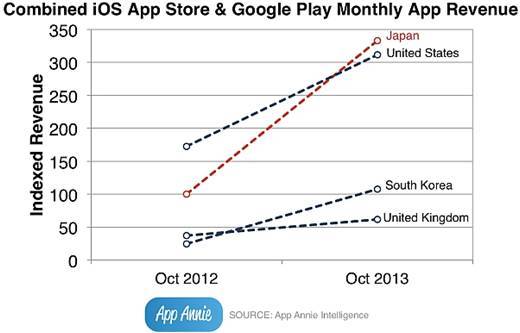Note: This website was automatically translated, so some terms or nuances may not be completely accurate.
Smartphone Games and TV Commercials

Yamamoto Satoshi
Dentsu Inc.
I'm Satoshi Yamamoto from Dentsu Inc. Smart Planning.
Dentsu Inc. Smart Planning, a planning unit contributing to the launch, growth, and expansion of businesses on smart devices like smartphones, consists of junior to mid-level employees handling smartphone service clients. Many members are avid gamers, making it a team capable of analysis and planning from a user perspective.
This column's theme is "Smartphone Games and TV Commercials." I'd like to focus on sharing experiences from producing commercials for smartphone games and apps I've worked on, along with insights gained through that work.
1. The Effectiveness of TV Commercials Revealed by Airtime Volume
According to survey data released by App Annie late last year, Japan's smartphone app sales surpassed those of the United States to become the world's largest.

Within this market, the most rapidly growing app category is games.
There is no doubt that TV commercials are the engine driving this upward growth. Looking at the monthly broadcast frequency by company, six smartphone game (app) companies have ranked in the top 10 over the last six months (March to August 2014). The reason all these companies are aggressively running TV commercials is that TV ads deliver overwhelmingly effective results that justify the investment. To get many people to play their games, the reach of TV commercials is indispensable.
2. Can Action Be Prompted Without Moving Hearts?
While smartphone game companies invest heavily in commercials, how do viewers actually feel about them? Looking at surveys like CM Data Bank's favorability ratings, smartphone game commercials rarely make it into the top 10. However, they do consistently translate into tangible results: downloads.
This suggests viewers who see TV commercials intuitively search for the game, start playing casually, and if hooked, invite others to join them. In other words, users follow a behavior model close to the AISAS model(※1), where TV commercials fulfill the roles of Attention and Interest.
Furthermore, considering that many smartphone games operate as Free-to-Play services, the barrier between Search and Action (purchase, in this case download) within the AISAS model can be considered lower compared to other paid products. Therefore, it is possible to get users to download smartphone games without necessarily leaving a strong impression of the commercial on viewers or even arousing a strong Desire to play.
In fact, I recall a commercial I worked on previously that ranked highly in favorability surveys. However, in terms of user acquisition, no correlation with favorability was observed, and it failed to deliver the expected results.
Similarly, on another client's commercial project, we aimed for an impactful ad. While it generated the desired buzz on social media and web news, it failed to meet our user acquisition targets, leading us to switch to a new commercial. An interesting phenomenon occurred then. When I mentioned the service to family and acquaintances, they all uniformly responded, "Oh, that's the one with the XX commercial, right?"—referring to the first commercial. This reaction wasn't limited to me; it also occurred among the client's own circle. It's clear that the first commercial left a deeper impression (in the hearts) of the viewers.
3. Desire and Purchase Behavior Unique to Mobile Games
I mentioned that the download behavior for mobile games doesn't involve Desire, following the AISAS model. However, most Free-to-Play mobile games use an item-based monetization model. As users download and progress through the game, a certain number engage in the purchasing behavior of "making in-app purchases." This means that after Search and Action (download), a behavior unique to mobile games occurs.
That is: Try ⇒ Enjoy ⇒ Desire.
First, players try the game, discover its appeal, and enjoy it. Then, some users progress further by making in-game purchases for items, etc. This is a characteristic unique to mobile games, not seen in traditional console games.
This user behavior reveals that "Desire is created later."
This resembles the approach of direct mail marketing, like free cosmetic samples. TV commercials prompt people to first try the free trial kit (Try). Then, they recognize the product's quality (Approve), which sparks the desire to buy (Desire). While mobile games make it easier to get people to Try due to the nature of devices and digital content, TV commercials serve the same fundamental role.
However, a major difference lies in the fact that "getting hooked (Enjoy) generates impulsive desire (Desire), making it easier to directly lead to purchase." Beyond the fundamental reason that games are entertainment, the smartphone's characteristic of enabling purchase with just one finger creates Desire (desire) ≈ purchase. As mentioned in previous columns, many people impulsively click to buy in a moment of heart's desire.
These three actions—TED (Try ⇒ Enjoy ⇒ Desire)—represent user behavior that cannot be ignored in the smartphone game business.
4. Promoting a Game's Uniqueness Boosts TED
The smartphone game market has experienced explosive growth in recent years. The image of mobile games from just a few years ago is rapidly fading. Behind this lies the success of numerous groundbreaking games that pursued "unique game experiences" by leveraging device specifications. This success stems from users embracing smartphone games not merely as time-killers, but as original and engaging entertainment.
Given this, it becomes crucial for TV commercials to promote the game's uniqueness as "a game that is [specific trait]" to encourage users to Try it. Users who start playing after seeing such a commercial begin their experience imagining the game's unique enjoyment as "a game that is [specific trait]." Consequently, this not only encourages Trying but also boosts the user's Enjoyment, ultimately leading to Desire and subsequent purchase.
Promoting a game's uniqueness essentially means finding and depicting its distinctive sizzle. Just as a free cosmetic sample commercial depicts daily fresh-faced expressions to make viewers imagine "skin with bounce," and then lets users who Try it experience that effect, it's about depicting the game's unique sizzle that makes it seem fun. I recall a time when most mobile games were still for feature phones. A renowned creative director once lamented, "Capturing sizzle is difficult. Showing the gameplay screen makes it look unappealing, and even if someone is smiling while holding the phone, it doesn't look like a game." Now that smartphones are mainstream, it's clear that more can be conveyed through commercial expression. Compared to back then, you can actually feel that commercials conveying game sizzle have increased. By conveying the game's unique appeal—whether it's fun gameplay, the potential for lively group excitement, an emotionally resonant story, or the ability to get deeply absorbed solo—using the tone and manner that best conveys it (like energetic, middle-schooler vibe, moe, smiles, youthfulness, or authenticity), you create that game sizzle that drives TED forward.
The reason for making in-game purchases at that moment is the "Because, you know, ○○" approach introduced in a previous column. If you can spark the Desire, users will find their own reasons to buy. In other words, if a TV commercial can concretely convey the Enjoyment, it becomes possible to design the entire flow—from the user's TED (Trial, Engagement, Download) to the subsequent purchase.
Finally, effective commercials cannot be created without understanding the unique appeal of the game and who it resonates with. It is essential to accurately grasp the user's fundamental insights, which cannot be fully revealed through user behavior analysis alone. At Dentsu Inc. Smart Plus, we use our proprietary "Smartphone Purchase Clusters" derived from original research to develop communication strategies. This includes identifying which types of people are receptive to a given game and how best to approach that demographic. Who are today's users? Who should we target with what message to encourage them to Try? By accurately grasping these points, we aim to increase user retention while growing the fanbase for both the game and the company.
Precisely because fun smartphone games are proliferating, we hope to see more and more people playing not just to kill time, but because they genuinely enjoy it.
※1 AISAS is one model explaining the purchasing behavior process.
It identifies the following five stages in the purchasing process:
Attention ⇒ Interest ⇒ Search ⇒ Action ⇒ Share

◎What is "Dentsu Inc. Smartpla"?
It is a planning unit that contributes to the launch, growth, and expansion of businesses on smart devices (such as smartphones, PCs, and tablets).
Our team includes diverse professionals such as strategic planners, communication planners, consultants, copywriters, and producers, all with extensive experience in marketing communications for smartphone games and apps. Furthermore, as each member possesses a deep passion for specific subjects, we support marketing activities by not only delving deeply into challenges but also engaging clients with our unique personalities and human skills.
Was this article helpful?
Newsletter registration is here
We select and publish important news every day
For inquiries about this article
Back Numbers
Author

Yamamoto Satoshi
Dentsu Inc.
Second CR Planning Bureau
Communication Planner
Born in 1983. Joined Dentsu Inc. in 2006. As an account executive, primarily handled mobile game platforms and app companies. Even after transferring to the planning section, continues to handle numerous communication planning projects for IT startups and game companies, primarily focused on smartphones. Left Dentsu Inc. in 2018.